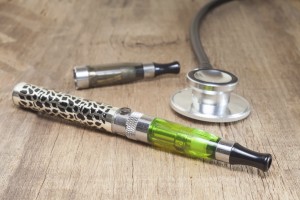 In case you have not explored e-cigarettes, we can summarize their characteristic workings. They look like a plastic cigarette or a long tubular pipe and they include a battery, a heating element, and a cartridge.
In case you have not explored e-cigarettes, we can summarize their characteristic workings. They look like a plastic cigarette or a long tubular pipe and they include a battery, a heating element, and a cartridge.
The cartridge can hold nicotine and many flavors and liquids. As you might imagine, some are rechargeable with refillable cartridges, but others are disposable. In Part I, the Florida Lung, Asthma and Sleep Specialists introduced you to several recent reports that e-cigs might not be as safe as their advertising claims.
FLASS would particularly like you to realize that “nicotine-free e-cig solutions were also found to include lung-harming substances, such as acrolein.” We believe you should know that this substance, which can be found both in the e-cig solution and in its vapor, “has been shown to damage the lungs by attacking the molecules that hold endothelial cells together.” As you might imagine, this is not very good for your life and breath!
Experts are calling for more research. Concerning her recent research, lung researcher, Irina Petrache, PhD stated, “This research reports that components found in commercially available e- cigarette solutions and vapors, generated by heating them, may cause lung inflammation.”
cigarette solutions and vapors, generated by heating them, may cause lung inflammation.”
Setting The Record Straight: Vaping and E-cigs–7 Things you should know!
Before you decide to try e-cigs, FLAS thinks you should be aware of the following main points:
1. There’s no doubt that nicotine inside the cartridges is addictive. It is not “kinder gentler nicotine. It causes the same withdrawal symptoms as cigarettes, if you chose to stop vaping.
2. Vaping can affect arteries as well as the heart, over time.
3. Yes, there is evidence to suggests that e-cigarettes may cause less lung damage than regular cigarettes. E-cigs don’t burn, so they have no danger from smoke. They do however, give off some of the same dangerous chemicals that come from a cigarette.
“E-cigarettes may be less harmful than cigarettes, but we still don’t know enough about their long-term risks or the effects of secondhand exposure.”
All current studies are short-term, and FLASS joins hundreds of other health experts in the appeal for more research on this subject.
Here in Orlando, at FLASS, we have to ask if you really want to experiment with your delicate lung tissues and new products containing elements like acrolein.
new products containing elements like acrolein.
4. You should know that “the FDA conducted lab tests and found detectable levels of toxic cancer-causing chemicals, including an ingredient used in antifreeze, in two leading brands of e-cigarettes and 18 various cartridges.”
5. Likewise, A 2014 research study discovered, “e-cigarettes with a higher voltage level have higher amounts of formaldehyde, a carcinogen.”
6. What about second-hand vapor? Although they do not burn, there are some irritating chemicals that can flow from the e-cig’s tantalizing vapor.
In addition to the studies that have found formaldehyde, researchers have found benzene, nitrosamines and acetaldehyde in the vapor emissions.
7. If you are trying to quit smoking, you should also be aware that “The FDA’s Center for Drug Evaluation and Research has not approved any e-cigarette as a safe and effective method to help smokers quit.”
We advise that smokers who are ready to quit, should call 1-800-QUIT-NOW or talk with their health care provider about using one of the seven FDA-approved medications proven to be safe and effective in helping smokers quit.”

